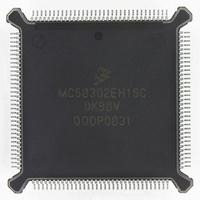MC68302EH16C Freescale Semiconductor, MC68302EH16C Datasheet - Page 158

MC68302EH16C
Manufacturer Part Number
MC68302EH16C
Description
IC MPU MULTI-PROTOCOL 132-PQFP
Manufacturer
Freescale Semiconductor
Datasheets
1.MC68302AG20C.pdf
(4 pages)
2.MC68302AG20C.pdf
(2 pages)
3.MC68302AG20C.pdf
(13 pages)
4.MC68302EH16C.pdf
(481 pages)
Specifications of MC68302EH16C
Processor Type
M683xx 32-Bit
Speed
16MHz
Voltage
5V
Mounting Type
Surface Mount
Package / Case
132-MQFP, 132-PQFP
Controller Family/series
68K
Core Size
32 Bit
Ram Memory Size
1152Byte
Cpu Speed
16MHz
No. Of Timers
3
Embedded Interface Type
SCP, TDM
Digital Ic Case Style
PQFP
Rohs Compliant
Yes
Family Name
M68000
Device Core
ColdFire
Device Core Size
32b
Frequency (max)
16MHz
Instruction Set Architecture
RISC
Supply Voltage 1 (typ)
5V
Operating Temp Range
0C to 70C
Operating Temperature Classification
Commercial
Mounting
Surface Mount
Pin Count
132
Package Type
PQFP
Lead Free Status / RoHS Status
Lead free / RoHS Compliant
Features
-
Lead Free Status / Rohs Status
RoHS Compliant part
Electrostatic Device
Available stocks
Company
Part Number
Manufacturer
Quantity
Price
Company:
Part Number:
MC68302EH16C
Manufacturer:
Freescale Semiconductor
Quantity:
135
Company:
Part Number:
MC68302EH16C
Manufacturer:
PANA
Quantity:
99
Company:
Part Number:
MC68302EH16C
Manufacturer:
Freescale Semiconductor
Quantity:
10 000
Part Number:
MC68302EH16C
Manufacturer:
FREESCALE
Quantity:
20 000
Company:
Part Number:
MC68302EH16CB1
Manufacturer:
Freescale Semiconductor
Quantity:
10 000
Company:
Part Number:
MC68302EH16CR2
Manufacturer:
Freescale Semiconductor
Quantity:
10 000
- MC68302AG20C PDF datasheet
- MC68302AG20C PDF datasheet #2
- MC68302AG20C PDF datasheet #3
- MC68302EH16C PDF datasheet #4
- Current page: 158 of 481
- Download datasheet (2Mb)
Communications Processor (CP)
The buffer descriptors may have their ready/empty bits set at any time. Notice that the com-
mand register (CR) does not need to be accessed following power-on reset. An SCC should
be disabled and re-enabled (see 4.5.10 Disabling the SCCs) after any dynamic change in
its parallel I/O ports or serial channels physical interface configuration. A full reset using the
RST bit in the CR is a comprehensive reset that may also be used.
4.5.8 Interrupt Mechanism
Interrupt handling for each of the SCC channels is configured on a global per-channel basis
in the interrupt pending register (IPR), the interrupt mask register (IMR), and the interrupt in-
service register (ISR). Within each of these registers, one bit is used to either mask or report
the presence of a pending or in-service interrupt in an SCC channel. However, an SCC in-
terrupt may be caused by a number of events. To allow interrupt handling for SCC-specific
events, further registers are provided within the SCCs.
Up to eight events can cause the SCC to interrupt the processor. The events differ in accor-
dance with the SCC protocol chosen. The events are handled independently for each chan-
nel by the SCC event register (SCCE) and the SCC mask register (SCCM). All unmasked
event bits must be cleared in order for the corresponding IPR bit to be cleared. The interrupt
handler typically reads the event register, and then immediately clears those bits that it will
deal with during the interrupt handler.
4.5.8.1 SCC Event Register (SCCE)
This 8-bit register is used to report events recognized by any of the SCCs. On recognition
of an event, the SCC will set its corresponding bit in the SCC event register (regardless of
the corresponding mask bit in the SCC mask register). The SCC event register is a memory-
mapped register that may be read at any time. A bit is cleared by writing a one (writing a
zero does not affect a bit's value).
4-38
3. Write SCON (see 4.5.2 SCC Configuration Register (SCON)).
4. Write SCM (SCC Mode) but do not set the ENT or ENR bits yet (see 4.5.3 SCC Mode
5. Write DSR as required if a protocol other than HDLC is used (see specific protocol sec-
6. Initialize the required values in the general-purpose parameter RAM (see 4.5.6 SCC
7. Initialize the required values in the protocol-specific parameter RAM (see specific pro-
8. Clear out any current events in SCCE, if desired (see specific protocol section).
9. Write SCCM to enable the interrupts in SCCE that should reach the interrupt controller
10. Write IMR in the interrupt controller to enable the SCC interrupt to the interrupt con-
11. Set the ENR and/or ENT bits in SCM (see 4.4.3 PCM Highway Mode).
(i.e., NMSI, PCM, GCI, IDL modes). If IDL or GCI is chosen in SIMODE, write SIMASK
in the serial channels physical interface (see 4.4.5 Serial Interface Registers).
Register (SCM)).
tion).
Parameter RAM Memory Map).
tocol section).
(see specific protocol section).
troller (see 3.2.5.3 Interrupt Mask Register (IMR)).
MC68302 USER’S MANUAL
MOTOROLA
Related parts for MC68302EH16C
Image
Part Number
Description
Manufacturer
Datasheet
Request
R
Part Number:
Description:
Manufacturer:
Freescale Semiconductor, Inc
Datasheet:

Part Number:
Description:
MC68302 Configuring the Chip Selects on the MC68302
Manufacturer:
Motorola / Freescale Semiconductor

Part Number:
Description:
MC68302 Design Concept - Expanding Interrupts on the MC68302
Manufacturer:
Motorola / Freescale Semiconductor

Part Number:
Description:
MC68302 MC68302 Adapting a WAN Controller to a LAN Environment
Manufacturer:
Motorola / Freescale Semiconductor

Part Number:
Description:
MC68302 EKB Applications - Power Measurements on the MC68302
Manufacturer:
Motorola / Freescale Semiconductor

Part Number:
Description:
MC68302 Interfacing the MC68020 to a Slave MC68302
Manufacturer:
Motorola / Freescale Semiconductor

Part Number:
Description:
MC68302 MC68302 Software Performance
Manufacturer:
Motorola / Freescale Semiconductor

Part Number:
Description:
MC68302 Evaluating EDX on the ADS302
Manufacturer:
Motorola / Freescale Semiconductor

Part Number:
Description:
MC68302 Design Advisory #1 - MC68SC302 Passive ISDN Protocol Engine
Manufacturer:
Motorola / Freescale Semiconductor

Part Number:
Description:
MC68302, MC68360, and MPC860 Characteristics and Design Notes for Crystal Feedback Oscillators
Manufacturer:
Motorola / Freescale Semiconductor
Part Number:
Description:
Mc68302 Integrated Multi-protocol Processor
Manufacturer:
Freescale Semiconductor, Inc
Datasheet:
Part Number:
Description:
Manufacturer:
Freescale Semiconductor, Inc
Datasheet:
Part Number:
Description:
Manufacturer:
Freescale Semiconductor, Inc
Datasheet:
Part Number:
Description:
Manufacturer:
Freescale Semiconductor, Inc
Datasheet:
Part Number:
Description:
Manufacturer:
Freescale Semiconductor, Inc
Datasheet:











